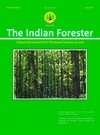Variability in Clones of Eucalyptus camaldulensis in Response to Elevated Carbon Dioxide and Temperature
DOI:
https://doi.org/10.36808/if/2017/v143i7/119015Keywords:
Eucalyptus camaldulensis, Climate Change, Relative Growth Rate, Clonal Variation, OTC.Abstract
Thirty clones of Eucalyptus identified as productive clones, through a systematic tree improvement programme at the Institute of Forest Genetics and Tree Breeding, Coimbatore were screened for their response to elevated carbon dioxide and temperature in Open Top Chambers (OTC). Based on Relative Growth Rate (RGR) and total biomass, clones were shortlisted. Seventeen clones which exhibited variation to the changes in elevated CO2 and elevated temperature were categorized as "climate change ready" clones those can withstand the adverse effects of climate change.References
Booth T.H. (2013). Eucalypt plantations and climate change. Forest Ecology and Management, 301:28-34.
Brown K. and Higginbotham K.O. (1986). Effects of carbon dioxide enrichment and nitrogen supply on growth of boreal tree seedlings. Tree Physiology, 2:223-232.
Cao B., Dang Q-L., Yu X. and Zhang S. (2008). Effects of [CO ] and nitrogen on morphological and biomass traits of white birch (Betula 2 papyrifera) seedlings. Forest Ecology and Management, 254:217-224.
Dhiman R.C. and Gandhi J.N. (2014). Status of Eucalypt clonal culture in India. In: Eucalypts in India (Bhojvaid, P.P., Kaushik, S., Singh, Y.P., Kumar, D., Thapliyal, M. and Barthwal, S., Eds.), ENVIS Centre on Forestry, Forest Research Institute, Dehradun, India. pp. 60-116.
Doran J.C., Pinyopusarerk K., Arnold R. and Harwood C.E. (1996). Breeding plan for Eucalyptus camaldulensis in Tamil Nadu. UNDP/FAO Regional Project on Improved Productivity of Man-Made Forests through Application of Technological Advances in Tree Breeding and Propagation. (RAS/91/004-FORTIP). 40p.
Gurumurti K., Bhandari H.C.S. and Negi D.S. (1988). Vegetative propagation of Eucalyptus, Indian Forester, 114:78-83.
Jayaraj R.S.C., Warrier R.R. and Balu A. (2014). A point grading method of clonal evaluation for resistance to gall in Eucalyptus. J. Andaman Science Association, 19(1):38-44.
Krishnakumar N., Sivakumar V. and Anandalakshmi R. (2014). Eucalypt improvement in Southern India. In: Eucalypts in India (Bhojvaid, P.P., Kaushik, S., Singh, Y.P., Kumar, D., Thapliyal, M. and Barthwal, S., Eds.), ENVIS Centre on Forestry, Forest Research Institute, Dehradun, India. pp. 139- 148.
Kulkarni H.D. (2014). Eucalypt improvement at ITC. In: Eucalypts in India (Bhojvaid, P.P., Kaushik, S., Singh, Y.P., Kumar, D., Thapliyal, M. and Barthwal, S., Eds.), ENVIS Centre on Forestry, Forest Research Institute, Dehradun, India. pp. 149-184.
Li Z., Zhang Y., Yu D., Zhang N. and Lin J. (2014). The influence of precipitation regimes and elevated CO on photosynthesis and biomass 2 accumulation and partitioning in seedlings of the rhizomatous perennial grass Leymus chinensis. PLoS ONE, 9(8): e103633. doi:10.1371/journal.pone.0103633
Madhu M. and Hatfield J.L. (2013). Dynamics of plant root growth under increased atmospheric carbon dioxide. Agronomy Journal, 105:657669.
Nowak R.S., Ellsworth D.S. and Smith S.D. (2004). Functional responses of plants to elevated atmospheric CO - do photosynthetic and 2 productivity data from FACE experiments support early predictions? New Phytologist, 162: 253–280.
Panse V.G. and Sukhatme P.V. (1995). Statistical Methods for Agricultural Workers. ICAR, New Delhi.
Poorter H. and Nagel O. (2000). The role of biomass allocation in the growth response of plants to different levels of light, CO , nutrients and 2 water: a quantitative review. Functional Plant Biology, 27(6): 595-607.
Poorter H., Niklas K.J., Reich P.B., Oleksyn J., Poot P. and Mommer L. (2012). Biomass allocation to leaves, stems and roots: meta-analyses of interspecific variation and environmental control, New Phytologist, 193:30-50.
Vanaja M., Maheswari M., Ratnakumar P. and Ramakrishna Y.S. (2006). Monitoring and controlling of CO concentrations in open top chambers 2 for better understanding of plants response to elevated CO levels. Indian J. Radio and Space physics, 35:193-197. 2
Wand S.J., Midgley G., Jones M.H. and Curtis P.S. (1999). Responses of wild C and C grass (Poaceae) species to elevated atmospheric CO 4 3 2 concentration a meta-analytic test of current theories and perceptions. Global Change Biology, 5: 723–741.
Warrier R.R, Buvaneswaran C., Priyadharshini P. and Jayaraj R.S.C. (2013). Growth response of three plantation species of the tropics exposed to elevated CO levels. J. Forestry Research, 24:449-456. 2
Warrier R.R., Priyadharshini P., Lalitha S. and Jayaraj R.S.C. (2016). Elevated CO influences physiological responses and assimilatory functions 2 on clones of Eucalyptus camaldulensis. J. Tree Sci., 35(1): 1-12.
Downloads
Downloads
Published
How to Cite
Issue
Section
License
Unless otherwise stated, copyright or similar rights in all materials presented on the site, including graphical images, are owned by Indian Forester.





